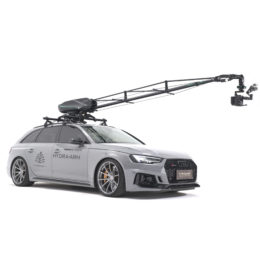The Hydra Arm Mini is a versatile device, but like any complex camera equipment, it may encounter issues from time to time. This troubleshooting guide will help you address common problems that may arise during operation. A PDF version is available for printing. Please follow the instructions below for each specific issue:
| Issue | Instruction |
|---|---|
| Remote signal, motor, and control icons appear functional, yet the Mini Arm remains unresponsive. | Ensure that the bottom shell button is not inadvertently pressed. |
| After powering on, the Mini Arm is restricted to movement in just one direction. | In regular operation conditions, press the bottom shell button. Manually align the Mini Arm to face directly forward and ensure it’s level. Once you shut down and restart, it should operate normally. |
| After startup, the Mini Arm behaves erratically. | Immediately activate the emergency stop button. Then, proceed with the joystick calibration procedure. Ensure both hands are OFF the joystick during this process. |
| Mini Arm malfunctions when attempting control after startup. | The proper startup procedure for the Mini Arm may not be followed properly. The left-right control, forward-reverse settings, and your manual operations aren’t synchronized or calibrated. |
| Difference between the emergency stop button and the pause knob | The emergency stop button is recommended when there’s uncertainty about controlling the Mini Arm. Activating this will lock the Tilt function, but allow the Pan to move freely. Furthermore, if the Mini Arm isn’t expected to be in use for a prolonged period, pressing the emergency stop button will shut off power to the motor, conserving battery life. Conversely, for short intervals without Mini Arm usage, it’s advisable to use the pause knob. |
| After powering on, there’s no display on the screen and the indicator light on the bottom shell is blinking. | This suggests that a cable may have come loose. Kindly turn off the device and inspect the connections. |
| After turning on, the Tilt axis grazes the ground during initial testing due to set limits. | Always ensure that the limits are set slowly and carefully. If the Tilt axis happens to touch the ground, press the button on the bottom shell while in control mode, manually elevate the Mini Arm, and restart. It should then operate as expected. |
| Vertical jitter when the Tilt axis stops. | This suggests that the titanium ruler dampers might not be optimally adjusted. |
| Horizontal wobbling when the Pan axis stops. | This suggests that the rotary dampers might not be optimally adjusted. |
| Vertical shaking is observed in the footage. | This suggests that the primary damping settings are not appropriately calibrated. Fine-tune the synchronization between the shock absorbing head and the gimbal head. |
| Horizontal shaking is observed in the footage. | This suggests that there’s suboptimal synchronization between the gimbal head and the shock absorbing head. |
| Signal is functional, yet no change in motor icons after engaging emergency stop. | This could be due to a disconnected motor drive or the main switch control line being unplugged. |
| Universal Troubleshooting Method | While in control mode, press the bottom shell button and manually adjust the Mini Arm to a visually horizontal tilt position. Navigate to the gyro calibration in the sub-menu, then turn off and restart. This general approach should address a majority of typical problems. |
| When the control arm swivels side to side, there’s a distinct jolt upon starting and stopping. The belt appears to be too loose. | Ensure even adjustment on both sides when tightening the belt, and always prioritize safety while making adjustments. |
| When filming, there’s a seesaw-like shake from side to side in the frame. This may be due to an overload, the damping plate being fully compressed, or the gimbal needing adjustment. | Replace with a heavy-duty damper plate (steel wire damper). Ensure the lateral damping adjustment isn’t too aggressive, and coordinate with the gimbal’s lateral damping settings. |
| Turret horizontal assembly, the function of the 4-Pin port located between the power socket and the control cable socket. | Electric suction cup interface; it’s used in conjunction with the optional electric suction cup accessory that can be purchased. |
| When the Tilt axis isn’t installed on the single Pan axis, the remote doesn’t respond and the light on the base flashes. | The turret needs to be fully assembled before use as a safety precaution. If any irregularities are detected in the turret’s wiring, the system will automatically enter a protective mode. |
| Problems with upgrading the remote controller on a MAC system. | Do not use a Type-C to Type-C data cable because it doesn’t support the required protocol. The computer side should have a standard USB port. |
| Belt misalignment issue. | Please contact customer service to request a belt retaining ring. |
| Shock absorber head’s left-right damping is leaking oil. | Check if the left-right damping has any sense of jamming. If not, replace it with a new rotary damping bracket. |
